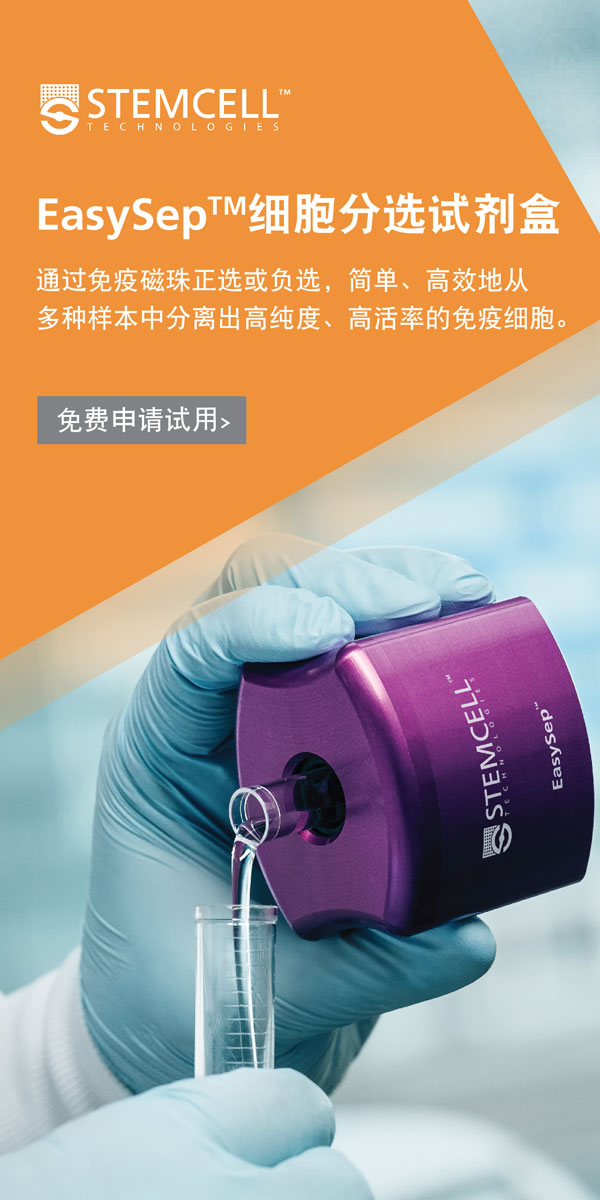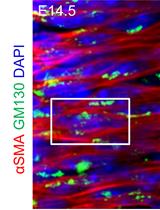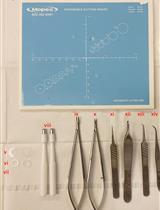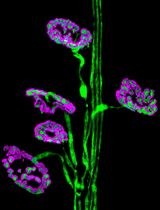- EN - English
- CN - 中文
Histochemical Staining of Collagen and Identification of Its Subtypes by Picrosirius Red Dye in Mouse Reproductive Tissues
使用天狼星红染料对小鼠生殖组织中胶原蛋白进行组织化学染色并鉴定其亚型
发布: 2017年11月05日第7卷第21期 DOI: 10.21769/BioProtoc.2592 浏览次数: 27062
评审: Andrea PuharRakesh BamAnonymous reviewer(s)
Abstract
Collagen is one of the foremost components of tissue extracellular matrix (ECM). It provides strength, elasticity and architecture to the tissue enabling it to bear the wear and tear from external factors like physical stress as well as internal stress factors like inflammation or other pathological conditions. During normal pregnancy or pregnancy related pathological conditions like preterm premature rupture of membranes (PPROM), collagen of the fetal membrane undergoes dynamic remodeling defining biochemical properties of the fetal membrane. The protocol in this article describes the histochemical method to stain total collagen by Picrosirius red stain which is a simple, quick and reliable method. This protocol can be used on paraformaldehyde (PFA) and formaldehyde fixed paraffin embedded tissue sections. We further describe the staining and distribution of collagen in different mouse reproductive tissues and also demonstrate how this technique in combination with polarization microscopy is useful to detect the distribution of different subtypes of collagen.
Keywords: Collagen (胶原)Background
Collagen is the principal load-bearing polymer in all connective tissues ranging from skin to bone. Collagen networks strongly stiffen when a mechanical force is applied, thus preventing excessive deformation of the tissue. There are 16 types of collagen, of which the type I, II, and III nearly comprise the 80% of the collagen in the body that are packed together to form long thin fibrils. Collagen type IV forms a two-dimensional reticulum; while several other collagen types are associated with fibril-type collagen, linking them to each other or to other matrix components. These collagens along with the other components of the extracellular matrix (ECM) undergo constant remodeling to provide required biochemical properties like tensile strength and elasticity. This unique attribute of collagen is one of the influencing factors of the stability of reproductive tissues and its dysregulation can lead to adverse events such as abnormal placentation, rupture of membranes (Hampson et al., 1997; Marpaung, 2016) and pathological conditions of the reproductive tract, such as endometriosis (Shimizu and Hokano, 1990) etc.
In tissues, the basement membrane is rich in collagen, in addition it is found in the stroma and lining the connective tissues. Physical, mechanical or chemical damage of a tissue or organ would lead to disruption of collagen deposition, and organization. Hence, assessing the patterns of collagen distribution would provide us an idea about the tensile strength of the tissue/organs. Any alterations from normal patterns of collagen distribution would imply tissue damage. In this study, chorio-decidual tissue has been used as a model basement membrane. Changes in the biochemical properties of this feto-maternal membrane during pregnancy and various pathological conditions lead to its preterm rupture (Sebire, 2001; Fujimoto et al., 2002; Wang et al., 2004; Vega Sánchez et al., 2004; Surve et al., 2016).
Sirius red is a histology stain used to mark total collagen as well as differentiate between varying collagen types for evaluation of collagen distribution in tissues. The sulphonic acid group of Sirius red reacts with basic amino groups of lysine and hydroxylysine and guanidine group of arginine (present in the collagen molecule (Junqueira et al., 1979)). Thereby, being an anionic dye, it attaches to all the varying types of collagen isoforms. In bright field, collagen appears as bundles of pink to red fibers which get disturbed in pathological conditions. The same larger collagen fibers under polarized light appear bright yellow to orange and the thinner ones, including reticular fibers, look green. This birefringence or double refraction, whereby incident light is split by polarization into two different paths, is highly specific for collagen. The amount of polarized light absorbed by the Sirius red dye stringently depends on the orientation of the collagen bundles enabling to differentiate different collagen types (Junqueira et al., 1979; Lattouf et al., 2014). This method is very simple, quick, economic and reliable in comparison with other commonly used staining methods for collagen.
Materials and Reagents
- Glass coverslips (HiMedia Laboratories, catalog number: CG108 )
- Glass slides (size, 76 x 26 mm) (HiMedia Laboratories, catalog number: CG029 )
- Paraffin mold and embedding cassette (Simport, catalog number: M490-2 )
- Mice strain: C57BL/6 Black (Experimental Animal Facility, ICMR-National Institute of Research in Reproductive Health)
- Distilled water (D/W)
- Formaldehyde (Sigma-Aldrich, catalog number: F8775 )
- Xylene (Merck, catalog number: 1086342500 )
- Methanol (Merck, catalog number: 1070182521 )
- Ethanol (Merck, catalog number: 1085430250 )
- Paraformaldehyde (Sigma-Aldrich, catalog number: P6148 )
- Sodium phosphate monobasic (NaH2PO4)
- Sodium phosphate dibasic (Na2HPO4)
- Sodium chloride (NaCl)
- Potassium chloride (KCl)
- Potassium phosphate monobasic (KH2PO4)
- Paraffin wax (Merck, catalog number: 1073371000 )
- Poly-lysine (Sigma-Aldrich, catalog number: P8920 )
- Picric acid (Fisher Scientific, catalog number: 13205 )
- Direct Red 80 (Sigma-Aldrich, catalog number: 365548 )
- Glacial acetic acid (CH3COOH) (Merck, catalog number: 1.93002 )
- Haematoxylin (C.I. 75290) (EMD Millipore, catalog number: 104302 )
- Iron(III) chloride (ferric chloride) (Merck, catalog number: 803945 )
- Sodium bicarbonate (Merck, catalog number: 106329 )
- Hydrochloric acid (37%) (Merck, catalog number: 1.93001 )
- D.P.X. mountant liquid (HiMedia Laboratories, catalog number: GRM655 )
- Weigert’s haematoxylin solution (see Recipes)
- 4% paraformaldehyde (PFA) (see Recipes)
- 10% formaldehyde (see Recipes)
- Phosphate buffered saline (PBS) (see Recipes)
- Poly-lysine coated glass slides (see Recipes)
- Picrosirius red solution (see Recipes)
- Acidified water (see Recipes)
Equipment
- Coplin jar (Thermo Scientific, catalog number: 107 )
- Bright field microscope (Leica, model: Leica DMi8 )
- Polarization microscope (Leica, model: Leica DMi8 )
Note: Items 2 and 3 are the same microscope. For polarization applications, a polarizer (Leica Microsystems, Germany) is placed in the light path of the bright field microscope.
- Hot plate (LED Digital, Lab Depot, model: MS7-H550-S )
- Microtome (Leica, model: Leica RM2255 )
Procedure
文章信息
版权信息
© 2017 The Authors; exclusive licensee Bio-protocol LLC.
如何引用
Bhutda, S., Surve, M. V., Anil, A., Kamath, K. G., Singh, N., Modi, D. and Banerjee, A. (2017). Histochemical Staining of Collagen and Identification of Its Subtypes by Picrosirius Red Dye in Mouse Reproductive Tissues. Bio-protocol 7(21): e2592. DOI: 10.21769/BioProtoc.2592.
分类
细胞生物学 > 组织分析 > 组织染色
免疫学 > 宿主防御 > 鼠
您对这篇实验方法有问题吗?
在此处发布您的问题,我们将邀请本文作者来回答。同时,我们会将您的问题发布到Bio-protocol Exchange,以便寻求社区成员的帮助。
Share
Bluesky
X
Copy link




















